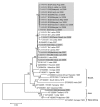Entomologic and virologic investigation of Chikungunya, Singapore
- PMID: 19751586
- PMCID: PMC2815960
- DOI: 10.3201/eid1508.081486
Entomologic and virologic investigation of Chikungunya, Singapore
Abstract
Local transmission of chikungunya, a debilitating mosquito-borne viral disease, was first reported in Singapore in January 2008. After 3 months of absence, locally acquired Chikungunya cases resurfaced in May 2008, causing an outbreak that resulted in a total of 231 cases by September 2008. The circulating viruses were related to East, Central, and South African genotypes that emerged in the Indian Ocean region in 2005. The first local outbreak was due to a wild-type virus (alanine at codon 226 of the envelope 1 gene) and occurred in an area where Aedes aegypti mosquitoes were the primary vector. Strains isolated during subsequent outbreaks showed alanine to valine substitution (A226V) and largely spread in areas predominated by Ae. albopictus mosquitoes. These findings led to a revision of the current vector control strategy in Singapore. This report highlights the use of entomologic and virologic data to assist in the control of chikungunya in disease-endemic areas.
Figures


References
-
- Hammon WM, Sather GE. Virological findings in the hemorrhagic fever epidemic (dengue) in Thailand. Am J Trop Med Hyg. 1964;13:629–41. - PubMed
-
- Shah KV, Gibbs CJ, Banerjee G. Virological investigation of the epidemic of hemorrhagic fever in Calcutta: isolation of three strains of chikungunya virus. Indian J Med Res. 1964;52:676–83. - PubMed
-
- Ministry of Health. Singapore. Chikungunya virus disease. Epidemiol News Bull. 2006. [cited 2009 Jun 2]. Available from http://www.moh.gov.sg/mohcorp/publicationsnewsbulletins.aspx?id=19542
Publication types
MeSH terms
Substances
LinkOut - more resources
Full Text Sources
Medical
